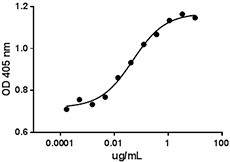- Regulatory Status
- RUO
- Other Names
- Dickkopf-related protein 1, DKK1

-

Recombinant Mouse DKK-1 enhances BMP9 induced alkaline phosphatase production in MC3T3-E1 cells with EC50 of 15 - 60 ng/mL.
| Cat # | Size | Price | Quantity Check Availability | ||
|---|---|---|---|---|---|
| 759602 | 10 µg | $147.00 | |||
| 759604 | 25 µg | $276.00 | |||
Select size of product is eligible for a 40% discount! Promotion valid until December 31, 2024. Exclusions apply. To view full promotion terms and conditions or to contact your local BioLegend representative to receive a quote, visit our webpage.
DKK-1 (Dickkopf related protein 1) is a member of the Dickkopf family of proteins that include DKK-1, -2, -3,-4, and Soggy. DKK-1 was discovered by its ability to block Wnt signaling during early Xenopus embryogenesis. DKK-1 antagonizes canonical Wnt signaling by inhibiting LRP5/6 interaction with Wnt proteins. DKK-1 forms ternary complex with LRP5/6 and the transmembane protein Kremen1/2, promoting internalization of LRP5/6 and down regulation of Wnt signaling. DKK-1 contains two conserved cysteine-rich domains separated by a linker region. N-terminal cysteine-rich domain is unique to DKKs while C-terminal cysteine-rich domain has a pattern of 10 cysteines similar to colipase fold. DKK-1 binds with LRP6 with high affinity and this interaction is enhanced by Kremens. The interactions between DKK-1 and both LRP6 and Kremens are mediated via C-terminal cysteine-rich domain. DKKs are expressed throughout development and play important role by locally inhibiting Wnt regulated processes such as limb development, somitogenesis, antero-posterior axial patterning, and eye formation. In the adult, DKKs are implicated in bone formation and bone disease, cancer and Alzheimer disease. The balance between Wnt signaling and DKK-1 inhibition is important for bone homeostasis. Increased expressions of DKK-1 are found in lung cancers, esophageal squamous cell carcinomas, and hormone-resistant breast cancers. DKK-1 expression is decreased in malignant melanoma and colorectal cancers. DKK-1 has been shown to partially abrogate Wnt3a dependent inhibtion of alkaline phosphase production in BMP2 stimulated osteoprogenitors.
Product Details
- Source
- Mouse DKK-1, amino acids Ser30-His272 (Accession# BC050189) was expressed in 293E cells.
- Molecular Mass
- The 243 amino acid recombinant protein has a predicted molecular mass of approximately 26.1 kD. The DTT-reduced protein migrate at approximately 35-45 kD and non-reduced protein migrate at approximately 30-40 kD by SDS-PAGE. The predicted N-terminal amino acid is Ser.
- Purity
- >95% as determined by Coomassie stained SDS-PAGE.
- Formulation
- 0.22 µm filtered protein solution is in PBS, pH 7.2.
- Endotoxin Level
- Less than 0.1 EU per µg of protein as determined by the LAL method.
- Concentration
- 10 and 25 µg sizes are bottled at 200 µg/mL.
- Storage & Handling
- Unopened vial can be stored between 2°C and 8°C for up to 2 weeks, at -20°C for up to six months, or at -70°C or colder until the expiration date. For maximum results, quick spin vial prior to opening. The protein can be aliquoted and stored at -20°C or colder. Stock solutions can also be prepared at 50 - 100 µg/mL in appropriate sterile buffer, carrier protein such as 0.2 - 1% BSA or HSA can be added when preparing the stock solution. Aliquots can be stored between 2°C and 8°C for up to one week and stored at -20°C or colder for up to 3 months. Avoid repeated freeze/thaw cycles.
- Activity
- ED50 = 15 - 60 ng/mL as measured by its ability to enhance BMP9 induced alkaline phosphatase production in MC3T3-E1 cells.
- Recommended Usage
-
Bioassay
- Application Notes
-
BioLegend carrier-free recombinant proteins provided in liquid format are shipped on blue-ice. Our comparison testing data indicates that when handled and stored as recommended, the liquid format has equal or better stability and shelf-life compared to commercially available lyophilized proteins after reconstitution. Our liquid proteins are verified in-house to maintain activity after shipping on blue ice and are backed by our 100% satisfaction guarantee. If you have any concerns, contact us at tech@biolegend.com.
- Additional Product Notes
-
View more applications data for this product in our Scientific Poster Library.
- Product Citations
-
Antigen Details
- Distribution
-
Placenta, prostate, colon, spleen, and platelets.
- Function
- Wnt antagonist implicated in bone formation and bone disease, cancer and Alzheimer disease. Also promotes type 2 cell-mediated inflammation.
- Ligand/Receptor
- LRP5/6, Kremen-1, and Kremen-2.
- Bioactivity
- Measured by its ability to enhance BMP9 induced alkaline phosphatase production in MC3T3-E1 cells.
- Cell Type
- Embryonic Stem Cells
- Biology Area
- Stem Cells, Cancer Biomarkers, Neuroscience, Neuroinflammation
- Antigen References
-
1. Fedi P, et al. 1999. J. Biol. Chem. 274:19465-72.
2. Krupnik VE, et al. 1999. Gene. 238:301-13.
3. Mao B, et al. 2001. Nature. 411:321-325.
4. Mukhopadhyay M, et al. 2001. Dev. Cell. 1:423-434.
5. Tian E, et al. 2003. New Eng. J. Med. 349:2483-2494.
6. Niehrs C. 2006. Oncogene. 25:7469-7481.
7. Diarra D, et al. 2007. Nature Med. 12:156-163.
8. Fujita K, Janz S. 2007. Molecular Cancer 6:71.
9. Ahn VE, et al. 2011. Dev. Cell 21:862-873. - Gene ID
- 13380 View all products for this Gene ID
- UniProt
- View information about DKK-1 on UniProt.org
